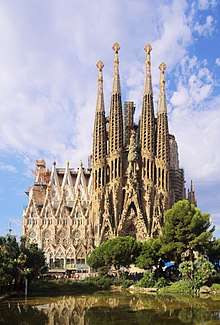Artesonado
Artesonado is a term for "a type of intricately joined wooden ceiling in which supplementary laths are interlaced into the rafters supporting the roof to form decorative geometric patterns",[1] found in Spanish architecture. Normally the decoration is in regular recesses between the rafter beams, and the woodwork is gilded or painted. It originates in Islamic Spain and North Africa, but was adopted in Christian Mudéjar architecture. The name comes from the Spanish word artesa, a shallow basin used in bread making.
Originating around the 13th century, it continued in use in the Renaissance, with a change of style to use motifs of classical origin.[2]
Notable examples of artesonado ceilings include those in the throne room of the Aljafería (Zaragoza), the Alhambra (Granada), the Chapterhouse of Toledo Cathedral, and the Royal Convent of Santa Clara (Tordesillas).
- Colonial artesonado in the Tlaxcala City Cathedral, Mexico
.jpg) Mudéjar artesonado dated to 1580, in the Basilica and Convent of Santo Domingo, Lima, Peru
Mudéjar artesonado dated to 1580, in the Basilica and Convent of Santo Domingo, Lima, Peru
References
| Wikimedia Commons has media related to Artesonados. |
- Maldonado
- Maldonado
- Maldonado, Basilio Pavón, "Artesonado", Grove Art Online, subscription required, accessed March 2019
